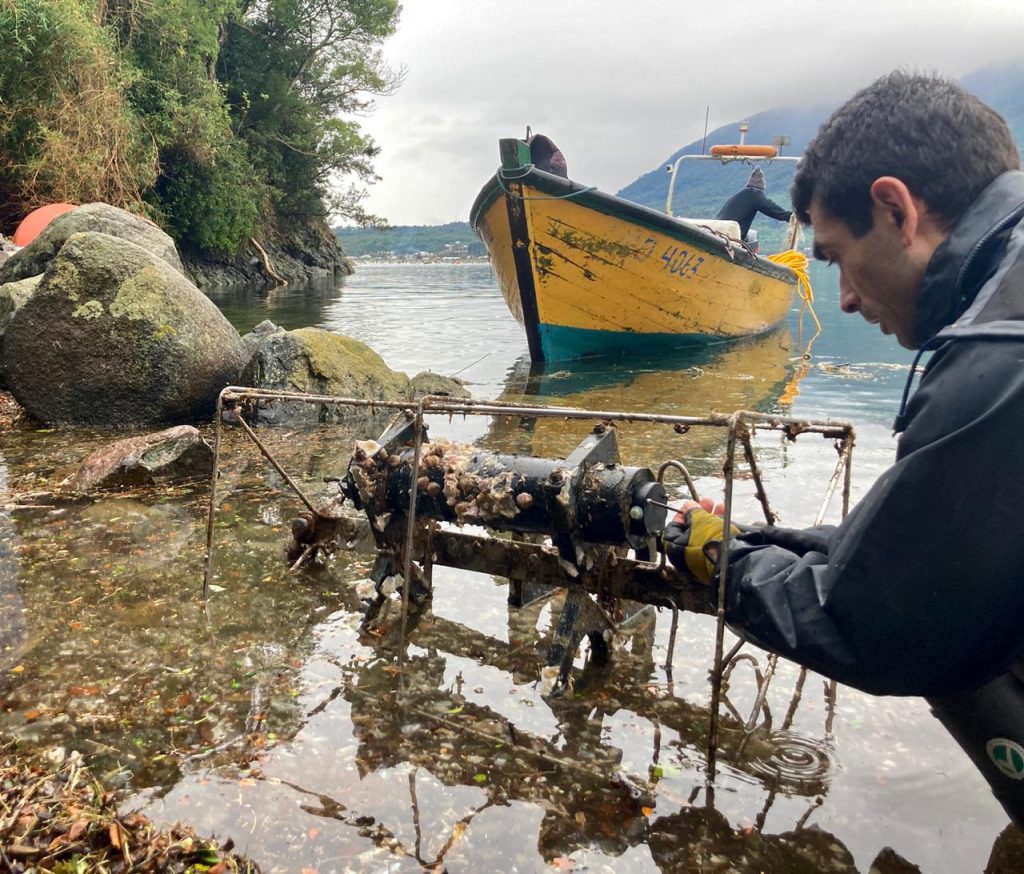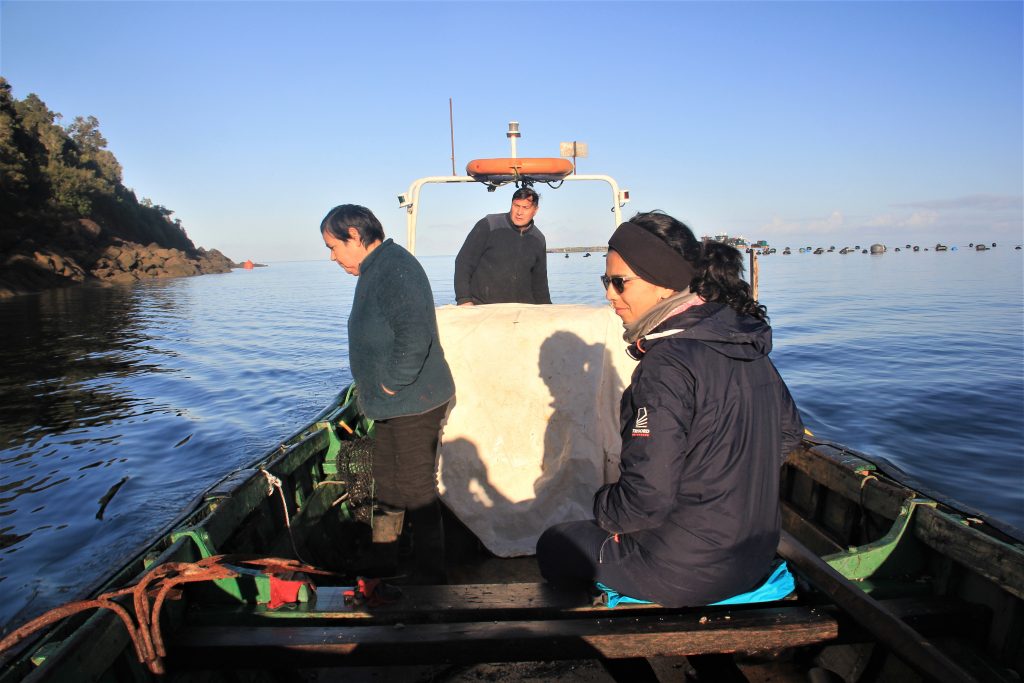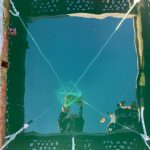
06 Aug SECOS Scientists Reinstall Monitoring System to Measure Environmental Variability in Caleta El Manzano
After more than a year of inactivity due to the pandemic, researchers from the Millennium Institute SECOS and fishers from Hualaihué reactivated the monitoring platform that, since 2018, has been measuring sea temperature, salinity, acidity, and other parameters. The platform aims to understand the dynamics of the marine environment in an important area for mussel seed collection, artisanal fishing, and shore gathering.
In the heart of the inland sea of Chiloé, the municipality of Hualaihué and Caleta El Manzano surprise with calm waters nestled among hills and native forests. In this area, shaped by aquaculture and mussel farming, José Erasmo González, a fisherman and president of the Puntilla Quillón Fishers’ Union, has been working for over 12 years in the aquaculture of chorito (Chilean mussel), capturing seeds in a zone he has known his entire life. For him, the variability in sea conditions in recent years has altered the timing of planting and seed collection for the main export product of national mussel farming: the chorito.
Understanding these variations and, above all, being able to anticipate them to make better decisions is key for his work and that of hundreds of fishers and communities living in the area. In early August, a group of researchers from the Millennium Institute for Coastal Socio-Ecology (SECOS), with the help of Erasmo and Maida, his wife and work partner, completed the reactivation of the environmental variability monitoring platform in Caleta El Manzano—a zone recognized for its significant chorito seed collection for national producers. In fact, according to the 2020 Fisheries and Aquaculture Sectoral Report, as of March of that year, 100% of chorito harvests took place in the Los Lagos Region, and this species represented 30.4% of the national harvest and 98.2% of mollusk farming.
In this context, the monitoring system was initially installed by the Millennium Nucleus MUSELS in August 2018 and, today, after more than a year of inactivity due to the pandemic, it is once again operational to deliver valuable data on sea conditions. After this time, the monitoring equipment was extracted, covered in epibiota and hidden beneath mussels, cholgas, picorocos, and other organisms abundant in the area. “The first step was to begin cleaning the equipment to see what was underneath.
We wanted to verify the conditions, whether it was still working, and whether data could be extracted. It was meticulous work because the equipment was very important and delicate to recover,” recounts Javiera Veloso, support professional at SECOS dedicated to coastal socio-biology and part of the team that successfully reinstalled the platform supporting the measurement instruments in Hualaihué. Through this platform, data is obtained on temperature, salinity, dissolved oxygen, fluorescence, turbidity (WQM), and pH (SeaFET), which allow for observation of variability in the area, changes caused by stressors, or by local processes (river influence, economic or human activities, among others), and also broader environmental changes.
“The goal is to characterize the environmental conditions in which the cultures develop, to see how climate change and global change are affecting them. We need to understand the context; it’s impossible to know how the future will impact you if you don’t understand the present,” explains Cristian Vargas, PhD in Oceanography and SECOS researcher. “We chose Hualaihué because this place has strong potential in terms of development with the local community; they are very proactive, enthusiastic about the platform, and see the value of observing the ocean, therefore they protect and care for it,” adds the academic from the Faculty of Environmental Sciences at the University of Concepción.
Joint Monitoring
The data and reports obtained in previous years in this area have been useful to public agencies such as IFOP, Sernapesca, and Subpesca, as well as to professionals in academia. Today, the challenge for SECOS researchers is for that information to be used in real time also by fishers, gatherers, and aquaculturists in Hualaihué. Thus, the installation and maintenance of the equipment is a joint effort with the Hualaihué community, who have been key in understanding the history of the caleta and the environmental changes.
“It’s important to work so that the community takes ownership of the equipment, but also of the usefulness of monitoring the ocean and being able to predict future conditions by knowing their variability ranges, to be more efficient in the work they do. Our mission is to provide baseline information to be prepared for possible changes or events that may occur in the sea—for example, making visible with concrete information whether the various aquaculture projects being carried out in the area generate effects on seed collection conditions or not,” says Antonio Cuevas, SECOS researcher in charge of the platform and UdeC academic.
Both the scientists and the president of the Puntilla Quillón Fishers’ Union agree that to achieve better characterization and to capture sea dynamics, integrating the experience and traditional knowledge of Hualaihué’s inhabitants is vital. “We have been combining our artisanal techniques and the knowledge acquired from years working at sea with the information provided by the system, which has been especially useful regarding temperature,” says José Erasmo González. “Local authorities need to know that this is something serving the people—artisanal fishers, aquaculturists, and those of us who work with the sea. Knowing this is possible, and it’s necessary to have real-time monitoring,” he said.
For the researchers, the plan is to develop an interface that allows for real-time visualization of what is happening in the sea, so that the data obtained can be reviewed directly by the fishers to make decisions. Today, the information must be collected directly from the instruments that measure temperature, salinity, dissolved oxygen, chlorophyll, turbidity, and acidity every hour. And although the data is available on a public server—accessible to other scientists—and periodic reports are issued, the challenge is to make the information provide tools for making those decisions more efficiently and in real time for fishers.
“The community understands that knowing the changes taking place in the physical factors of the area will have, in the near future, major repercussions for their work. We need to continue creating opportunities to inform the community about what we are doing, what is happening in the sea, and how this will be useful to them in the future,” concludes Javiera Veloso, who, along with Antonio Cuevas and Erasmo González, will return in a couple of months to retrieve the instruments suspended in the water column from the platform, to collect new data that will unravel the present and future story of Caleta El Manzano in Hualaihué.










